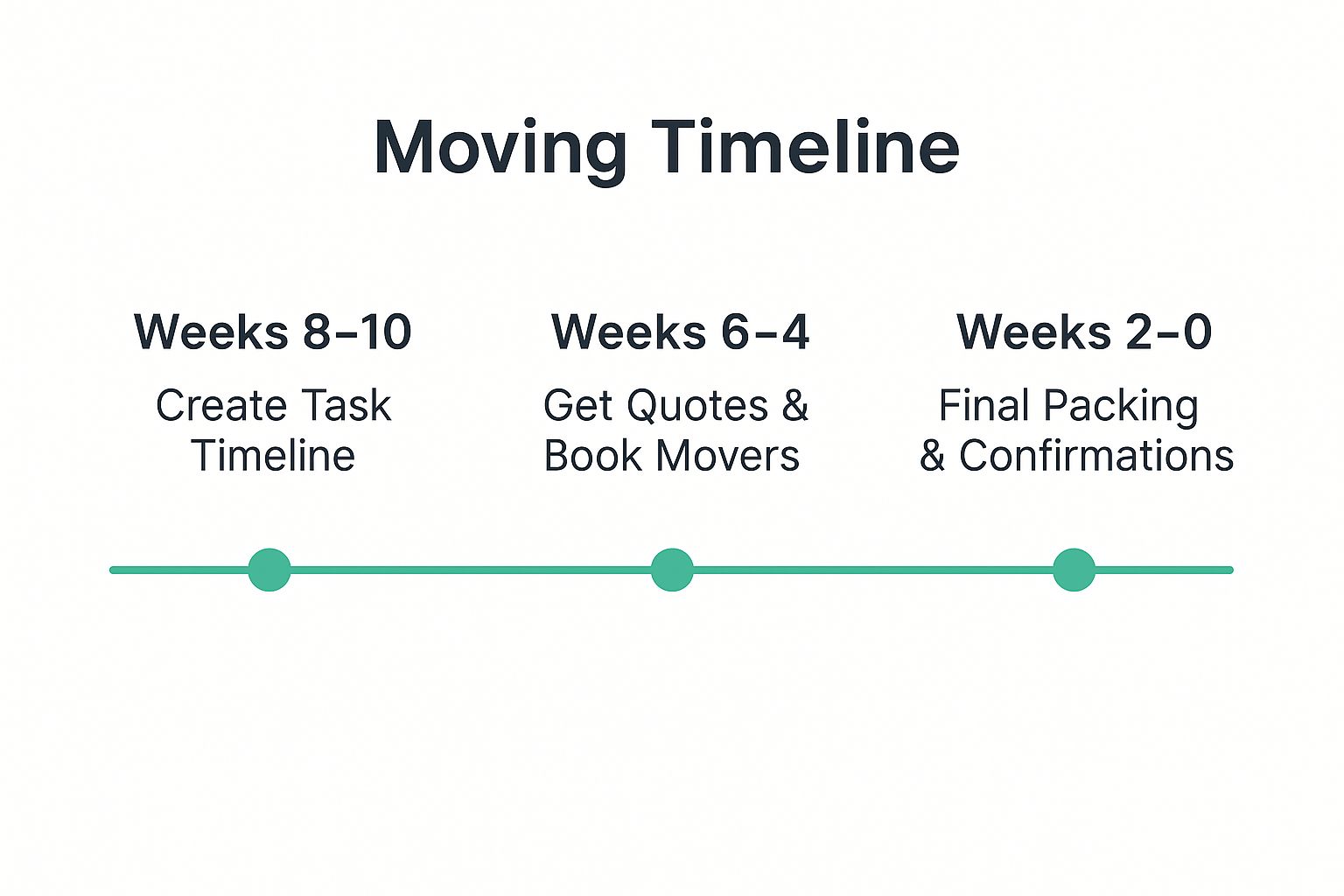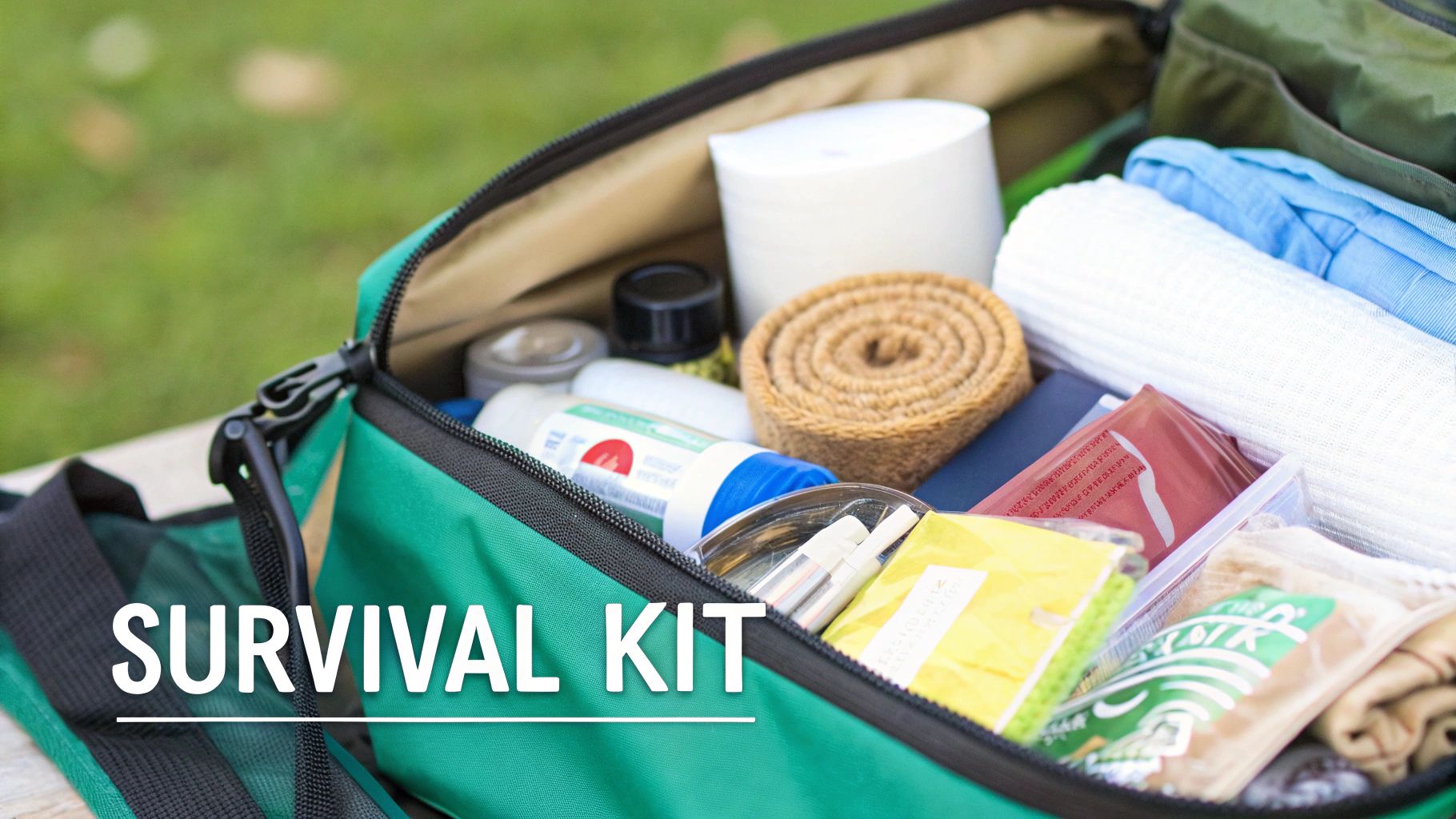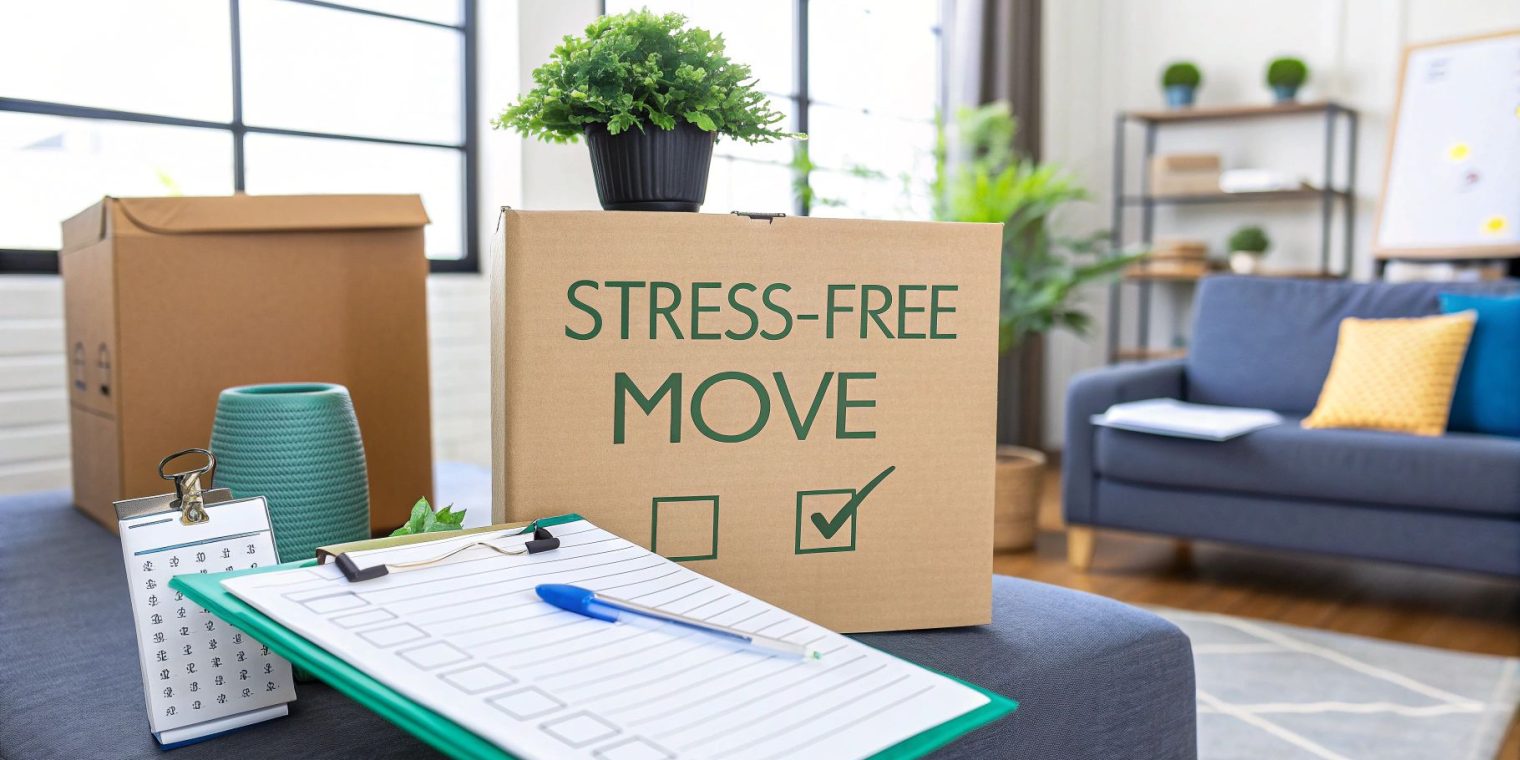Moving house is consistently ranked as one of life's most stressful events, often sitting alongside major life changes like a new job or the end of a relationship. The combination of logistical complexity, emotional upheaval, and financial pressure creates a perfect storm for anxiety. But what if you could navigate this transition with confidence and calm? The key isn't to eliminate stress entirely; it's to manage it effectively. By shifting from a reactive mindset to a proactive one, you can transform the experience from overwhelming to organised.
This guide focuses on actionable strategies that directly combat the root causes of moving house stress. We'll provide a curated roundup of seven powerful, proven tactics, covering everything from strategic planning and smart decluttering to leveraging professional help and prioritising your well-being. For those facing an particularly complex international or long-distance relocation, it's also worth remembering that some solutions can significantly reduce your immediate workload. To minimise initial worries and streamline your transition, considering options like searching for furnished apartments for a smooth, stress-free move can be a strategic decision.
Whether you're moving across town or just to a new suburb, these insights will equip you to handle your relocation with precision and peace of mind, ensuring your new chapter begins on the best possible note.
1. Start Planning 8-10 Weeks in Advance
The single most effective strategy to minimise moving house stress is to trade panic for preparation. Procrastination is the primary driver of moving-day chaos, leading to rushed decisions, forgotten tasks, and unnecessary expenses. By adopting a structured planning approach 8 to 10 weeks before your moving date, you transform an overwhelming project into a series of small, achievable goals. This method is a standard practice for corporate relocation specialists and military families, groups who understand that meticulous, long-range planning is the key to a smooth transition.
How to Create Your Moving Timeline
The goal is to deconstruct the entire move. Start with a master list of everything that needs to be done, from decluttering the spare room to redirecting your mail. Then, work backwards from your move date, assigning these tasks to specific weeks.
- Use a Visual Calendar: A large wall calendar or a digital planner allows you to see your entire timeline at a glance. Colour-code tasks by category, such as packing, administration, and cleaning.
- Establish Weekly Check-ins: Dedicate a specific time each week, perhaps Sunday evening, to review your progress, adjust priorities, and plan for the week ahead.
- Integrate Digital Tools: Moving apps like Sortly can help you catalogue your belongings, while project management tools can track task completion. To ensure all your critical moving appointments and deadlines are logged, consider tools that offer an effective add-to-calendar function.
This visual timeline breaks down the planning process into three distinct, manageable phases.

As the infographic illustrates, spreading major milestones across the two-month window prevents a last-minute scramble and gives you control over the entire process.
2. Declutter and Downsize Before Packing
One of the most profound sources of moving house stress is the sheer volume of stuff we accumulate. Packing, moving, and unpacking items you no longer need, use, or love isn't just inefficient; it's mentally and financially draining. The act of decluttering before you pack is a strategic move to simplify the entire process, reducing physical labour, moving costs, and the time it takes to settle into your new home. This principle is championed by minimalism advocates and is a standard practice for military families who must regularly downsize to meet strict relocation weight limits.
How to Systematically Declutter
The key is to be methodical, not emotional. Approaching this task with a clear system prevents overwhelm and ensures you only move what truly matters. Start at least 6-8 weeks before your move date to give yourself ample time without feeling rushed.
- Implement the Four-Box Method: For each room, set up four distinct zones or boxes: Keep, Donate/Sell, Discard, and Relocate. The 'Relocate' box is for items that belong in a different room, helping you organise as you declutter.
- Follow the One-Year Rule: A simple but effective guideline. If you haven't used an item in the last 12 months and it holds no significant sentimental value, it’s a strong candidate for donation or disposal.
- Start with Low-Hanging Fruit: Begin with the least emotionally charged areas, like the laundry, linen cupboard, or junk drawer. Clearing out expired products, old paperwork, and broken items builds momentum and confidence for tackling more sentimental categories later.
This structured approach transforms decluttering from a daunting chore into a liberating first step. For items you want to keep but won't need immediately in your new home, or for those you're not quite ready to part with, exploring solutions like those available with self storage in Newport can be an excellent interim strategy. It allows you to move into an uncluttered space while giving you more time to make final decisions.
3. Research and Book Professional Movers Early
Selecting the right moving company is a critical decision that directly impacts the level of moving house stress you experience. Choosing a reputable, professional service transforms the logistical burden into a managed process, whereas a poor choice can lead to lost items, hidden fees, and immense frustration. By researching and booking your movers well in advance, you secure reliable help and avoid the high-demand, low-availability crunch that occurs during peak moving seasons, such as summer holidays.
How to Vet and Select Your Moving Company
The objective is to find a trustworthy partner for your move, not just the cheapest option. This requires due diligence to verify credentials, compare services, and understand contract terms. Corporate relocation policies almost exclusively mandate the use of pre-vetted professional services because it guarantees a baseline of quality and accountability.
- Gather Multiple Quotes: Contact at least three different moving companies to obtain detailed, written estimates. A company that only gives a quote over the phone without seeing your belongings is a major red flag. This comparative process helps you gauge fair market pricing and identify outliers.
- Verify Credentials and Reviews: Check for proper licensing and insurance. For local moves in Western Australia, for instance, you can look for established companies with a strong local presence. Reading recent reviews across multiple independent platforms like Google, the Better Business Bureau (BBB), and local directories provides a more balanced view of a company's performance.
- Clarify Service Inclusions: Ask specific questions. Does the quote include packing materials, furniture disassembly/reassembly, and insurance for your belongings? Understanding exactly what you are paying for prevents unexpected charges on moving day. For a detailed look at what professional services should cover, you can find valuable insights by reviewing local experts like Joondalup removalists.
Booking your chosen company 6-8 weeks ahead of your move date is especially important for weekend or end-of-month moves. This advance planning not only secures your preferred date but also locks in pricing before seasonal demand drives costs up, giving you one less major thing to worry about.
4. Create a 'Moving Day Survival Kit'
Even with the most organised move, there's always a period of controlled chaos as boxes are unloaded. A 'Moving Day Survival Kit' is your personal, readily accessible box of essentials for the first 24 to 48 hours in your new home. This kit travels with you in your car, not in the moving truck, ensuring that even if you're too exhausted to unpack, you have everything needed to function comfortably. This practice is heavily relied upon by military families and corporate relocation specialists, who know that immediate access to essentials is crucial for mitigating moving house stress.

How to Assemble Your Survival Kit
The objective is to gather items that will allow you to eat, clean up, and solve minor problems without rummaging through dozens of packed boxes. Think of it as a carry-on bag for the first night in your new property. Keep the kit separate from all other moving boxes to avoid it being loaded onto the truck by mistake.
- Choose a Distinctive Container: Use a clear plastic tub or a brightly coloured bag. This makes it easy to identify amongst the sea of brown cardboard boxes and ensures it stays with you.
- Pack Key Categories: Your kit should cover basic needs. This includes kitchen essentials (kettle, coffee/tea, mugs, paper plates, cutlery), bathroom necessities (toilet paper, soap, towels, toothbrushes), and basic tools (multi-tool, box cutter, torch).
- Include Personal Comforts: Moving is draining. Pack items that will make you feel more at home, such as a favourite snack, a portable speaker for music, and chargers for all your electronic devices. A basic first-aid kit with pain relief, bandages, and antiseptic wipes is also a non-negotiable item.
By having these necessities on hand, you eliminate the frantic search for the box with the toilet paper or the coffee mugs. This simple act of preparation provides an immediate sense of control and comfort, significantly lowering the stress of that first night and turning a potentially chaotic experience into a manageable one.
5. Label Everything with a Detailed System
A major source of moving house stress isn't the move itself, but the chaotic aftermath of unpacking. An effective labelling system goes far beyond simply writing "Kitchen" on a box. It involves creating a detailed, systematic inventory that transforms unpacking from a stressful guessing game into a streamlined, organised process. This method helps you locate essential items instantly and makes settling into your new home significantly faster and less overwhelming. Professional organisers and museum relocation specialists rely on this level of detail to ensure every item is accounted for and placed correctly.
How to Create Your Labelling System
The objective is to make each box's contents, priority, and destination instantly clear to anyone handling it. Think of each label as a mini instruction manual for that specific box.
- Use a Multi-Point System: Every label should include three key pieces of information: the destination room (e.g., Main Bedroom), a summary of the contents (e.g., Bedside lamps, chargers, books), and a priority level (e.g., HIGH – Unpack First).
- Colour-Code for Clarity: Assign a different colour to each room in your new home. For instance, use blue tape or labels for the main bedroom, green for the kitchen, and yellow for the living room. This allows movers to quickly identify where boxes go without having to read every label, a small detail that saves immense time and confusion on moving day.
- Create a Master Inventory List: Number every box and log it in a corresponding digital spreadsheet or notebook. This master list should detail the box number, its colour code, its destination room, and a more thorough description of its contents. This becomes an invaluable reference if you need to find a specific item before everything is unpacked. For this system to work, you will need a consistent supply of quality containers; a guide on where to buy moving boxes can be a huge help.
As this video demonstrates, a strategic approach to packing and labelling on both sides of the box prevents the all-too-common scenario of hunting for the kettle or a phone charger amidst a sea of identical brown boxes.
6. Set Up Utilities and Services in Advance
Walking into a new home only to discover there is no electricity, hot water, or internet is a surefire way to amplify moving house stress. Coordinating the transfer and setup of essential services is a non-negotiable task that must be handled well before moving day. Neglecting this crucial step can lead to a chaotic first night and days, or even weeks, of frustrating delays, especially as many utility and service providers require significant lead time for new connections. Corporate relocation specialists and experienced real estate agents always place this task high on the priority list, as it's fundamental to a liveable, functional home from the moment you get the keys.
How to Coordinate Your Service Connections
The objective is to ensure a seamless transition of services from your old property to your new one, avoiding any overlap or gaps. This involves careful scheduling and clear communication with each provider.
- Create a Master Utility List: Develop a spreadsheet or document listing every service provider for both your old and new homes. Include account numbers, contact details, scheduled disconnection dates for the old address, and connection dates for the new one.
- Schedule Connections Strategically: Arrange for new services like electricity, water, and gas to be activated the day before you move in. This ensures everything is working when you arrive. Schedule internet and pay TV installations for as soon as possible after your move-in date, as these often require a technician.
- Document Final Readings: On your last day at your old property, take photographs of the final meter readings for electricity, gas, and water. This provides irrefutable evidence for your final bill and prevents potential disputes over usage.
- Research New Providers Early: Don't assume your current internet provider is the best or only option for your new area. Research alternatives at least a month in advance, as installation lead times, particularly in newly developed or regional areas, can be several weeks long.
By organising these services beforehand, you guarantee your new house feels like a home from the very first day, allowing you to focus on unpacking rather than chasing activation appointments.
7. Maintain Normal Routines Where Possible
One of the most powerful, yet often overlooked, strategies for managing moving house stress is to intentionally preserve your daily routines. The moving process inherently disrupts life, but clinging to familiar anchors of normalcy provides a critical sense of stability and control for everyone involved, from adults to children. This principle is a cornerstone for groups accustomed to frequent transitions, like military families, who understand that consistent routines are the bedrock of emotional resilience during upheaval.
How to Preserve Your Key Routines
The aim isn't to pretend nothing is changing, but to consciously protect the core activities that ground your family's daily life. Identify the most important routines that provide comfort and structure, then build your moving tasks around them, not the other way around.
- Identify Your Non-Negotiables: Is it the family dinner, a morning coffee ritual, or a regular workout? List the top 2-3 routines that have the biggest positive impact on your day.
- Adapt, Don't Abandon: You might not be able to cook a gourmet meal, but you can still eat together at the same time, even if it's takeaway on the floor surrounded by boxes. A 15-minute walk can replace a full gym session. The consistency of the act is more important than the perfect execution.
- Prioritise Sleep Hygiene: The temptation to pack late into the night is strong, but sleep deprivation dramatically magnifies stress. Stick to established bedtimes and wind-down rituals, especially for children. Reading a bedtime story can provide a vital moment of calm connection amidst the chaos.
By safeguarding these small pockets of predictability, you create a psychological buffer against the overwhelming nature of the move. It sends a clear message to your subconscious, and to your family, that even though the environment is changing, your life's essential rhythm remains intact.
7 Key Strategies for Reducing Moving Stress
| Strategy | Implementation Complexity 🔄 | Resource Requirements ⚡ | Expected Outcomes 📊 | Ideal Use Cases 💡 | Key Advantages ⭐ |
|---|---|---|---|---|---|
| Start Planning 8-10 Weeks in Advance | Moderate: Requires discipline and timeline management | Moderate: Time investment over weeks | Reduced stress, flexible handling of issues | Long-distance/interstate moves, corporate relocations | Reduces last-minute panic, better budget control |
| Declutter and Downsize Before Packing | High: Time-intensive, emotionally challenging | Moderate: Several weekends | Lower costs, less packing/unpacking time | Seniors downsizing, military moves, first-time movers | Cuts moving volume/costs, fresh start mentality |
| Research and Book Professional Movers Early | Moderate: Research and verification needed | High: Time for multiple quotes and vetting | Professional handling, faster, insured move | Peak season moving, long-distance or valuable moves | Reduces damage risk, saves physical strain |
| Create a 'Moving Day Survival Kit' | Low: Simple packing discipline required | Low: Basic supplies and organization | Immediate access to essentials, reduced anxiety | All moves, especially with delayed unpacking risks | Comfort and functionality on moving day |
| Label Everything with a Detailed System | Moderate: Time-consuming labeling process | Low: Labeling materials | Faster unpacking, less damage, priority unpacking | Complex moves, large households, high-value items | Speeds unpacking, improves handling accuracy |
| Set Up Utilities and Services in Advance | Moderate: Coordination and timing critical | Low to Moderate: Contacting providers | No service gaps, immediate home functionality | All moves, especially rural or corporate relocations | Avoids delays, prevents added stress |
| Maintain Normal Routines Where Possible | Low to Moderate: Requires planning and flexibility | Low: Routine items and effort | Emotional stability, smoother adjustment | Families with children/pets, stressful moves | Supports mental health, creates normalcy |
Your Next Chapter Starts Here, Stress-Free
Embarking on a move is undeniably one of life's more significant stressors, but it's crucial to remember that this pressure is temporary and, more importantly, manageable. While a degree of moving house stress is almost universal, it doesn't have to hijack the entire experience. The journey from your old front door to your new one can be one of organised calm rather than chaotic panic. By internalising and implementing the strategies we've explored, you are actively shifting from a reactive mindset to a proactive one, which is the cornerstone of a smooth relocation.
The key is to recognise that you hold the power to shape your moving experience. This isn't about achieving an impossible standard of perfection; it's about making deliberate, incremental progress. Each action you take, guided by a solid plan, directly dismantles the overwhelming sense of being swamped.
Recapping Your Blueprint for a Calmer Move
Let’s quickly revisit the core takeaways that will serve as your foundation:
- Early Planning is Your Greatest Ally: Starting 8-10 weeks out transforms a frantic rush into a series of manageable weekly tasks. This timeline is your most valuable asset.
- Declutter with Purpose: Remember, every item you decide not to take is one less thing to pack, move, and unpack. This step saves you time, money, and future effort.
- Leverage Professional Expertise: Booking reputable movers well in advance secures their service and provides immense peace of mind. It’s a direct investment in reducing physical and mental strain.
- Strategic Systems are Essential: From a detailed, colour-coded labelling system to a well-stocked ‘Moving Day Survival Kit’, these small organisational hacks have an outsized impact on reducing friction and anxiety on the big day.
From Surviving to Thriving in Your New Space
Mastering these approaches isn't just about getting through the move; it's about starting your next chapter on the best possible footing. An organised move leads to an organised unpacking process, allowing you to settle in and enjoy your new environment much faster. Instead of spending weeks wading through a sea of unidentified boxes, you can begin making your new house a home from day one. This sets a positive tone for the future, free from the lingering chaos of a disorganised relocation.
As you settle in, the focus naturally shifts from logistics to creating a safe and comfortable environment. For families, this next phase is particularly important. Taking the time to properly secure your new surroundings ensures a safe haven for everyone. If you have little ones, investing time in this area is non-negotiable, and resources like a practical room-by-room guide on how to childproof your new home can provide invaluable, actionable steps for added peace of mind. Ultimately, a successful move is one that ends with you feeling secure, happy, and ready for the future.
Ready to eliminate the biggest source of moving house stress? Let the professionals handle the heavy lifting. For a seamless, reliable, and carefully managed move anywhere in Perth, contact Emmanuel Transport today for your obligation-free quote and turn your moving plan into a reality.













